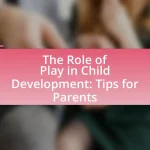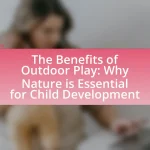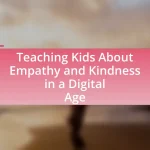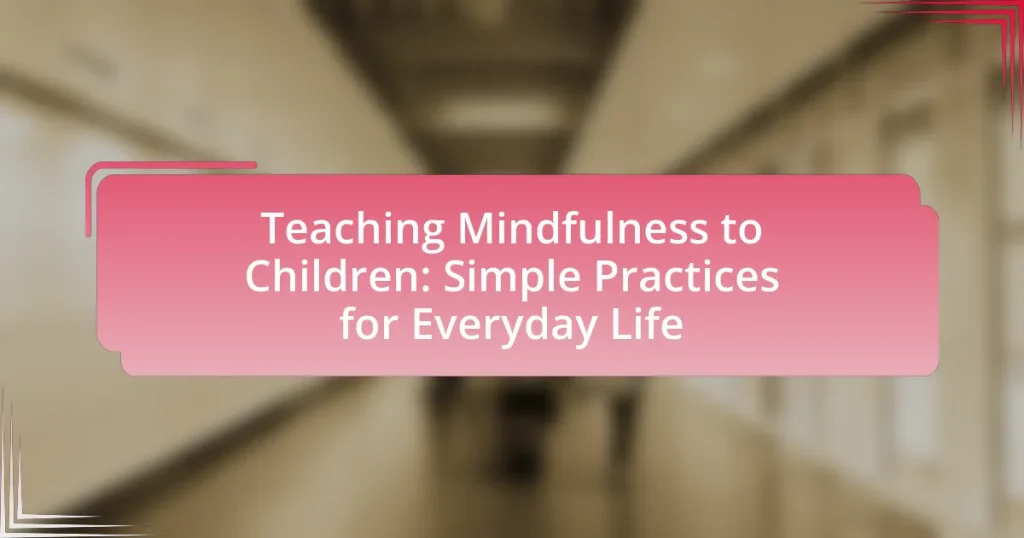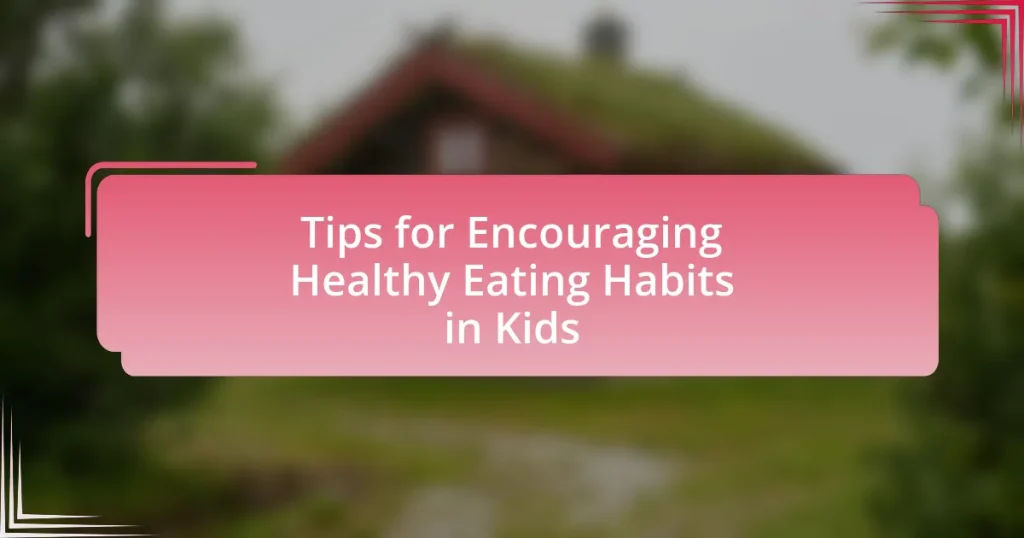Teaching mindfulness to children involves the practice of being fully present and engaged in the moment, which is crucial for their emotional regulation, stress reduction, and focus enhancement. The article outlines the definition of mindfulness in childhood, its key principles, and the psychological benefits it offers, such as improved attention spans and academic performance. It also discusses practical strategies for integrating mindfulness into daily life, including simple exercises like deep breathing and mindful observation, as well as ways parents and educators can support mindfulness practices. Additionally, the article addresses common challenges in teaching mindfulness and offers effective techniques to engage children in these practices.
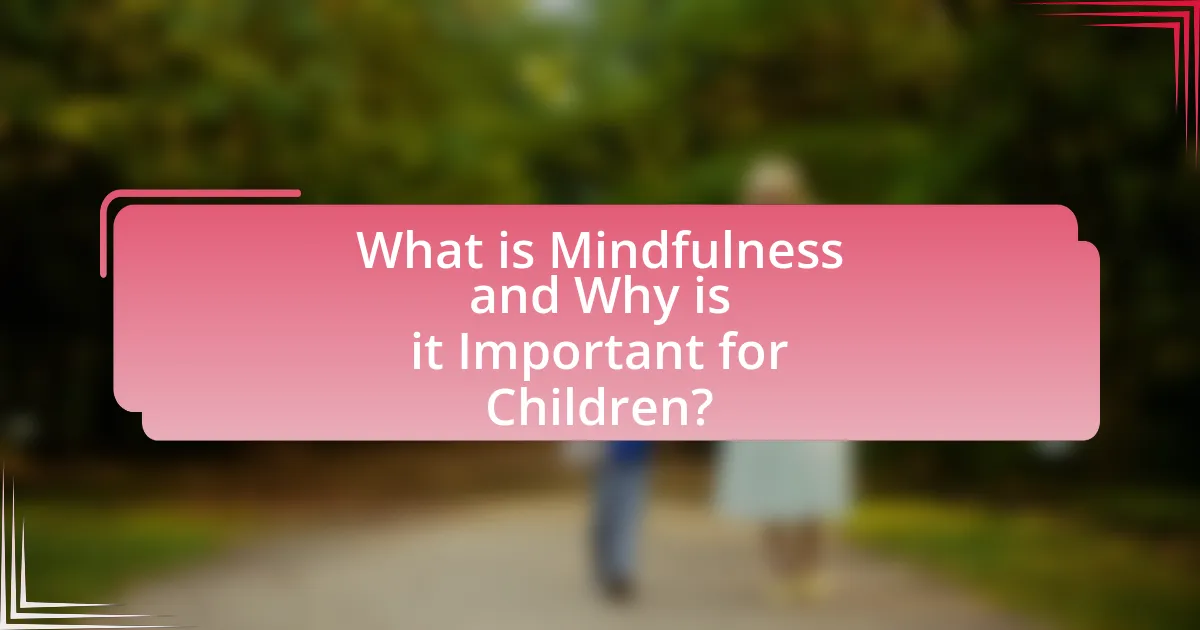
What is Mindfulness and Why is it Important for Children?
Mindfulness is the practice of being fully present and engaged in the moment, without judgment. It is important for children because it enhances their emotional regulation, reduces stress, and improves focus. Research indicates that mindfulness practices can lead to increased attention spans and better academic performance, as demonstrated in a study published in the journal “Psychological Science,” which found that children who participated in mindfulness training showed significant improvements in attention and behavior compared to those who did not. Additionally, mindfulness helps children develop empathy and resilience, equipping them with essential skills for navigating social interactions and challenges.
How can mindfulness be defined in the context of childhood?
Mindfulness in the context of childhood can be defined as the practice of being fully present and engaged in the moment, while acknowledging and accepting one’s thoughts, feelings, and bodily sensations without judgment. This definition is supported by research indicating that mindfulness can enhance emotional regulation, attention, and social skills in children, contributing to their overall well-being and development. Studies, such as those conducted by Zenner, Herrnleben-Kurz, and Walach in 2014, demonstrate that mindfulness practices can lead to significant improvements in children’s mental health and academic performance.
What are the key principles of mindfulness for children?
The key principles of mindfulness for children include awareness, acceptance, and attention to the present moment. Awareness involves recognizing thoughts, feelings, and sensations without judgment, which helps children understand their emotional states. Acceptance encourages children to embrace their experiences, fostering resilience and reducing anxiety. Attention to the present moment teaches children to focus on their current activities, enhancing concentration and reducing distractions. Research indicates that these principles can improve emotional regulation and social skills in children, as evidenced by studies showing that mindfulness practices lead to increased focus and decreased stress levels in educational settings.
Why is mindfulness particularly beneficial during childhood?
Mindfulness is particularly beneficial during childhood because it enhances emotional regulation and cognitive development. Research indicates that practicing mindfulness can lead to improved attention spans, reduced anxiety, and better social skills among children. A study published in the journal “Child Development” by Zoë A. K. H. H. H. H. H. H. H. H. H. H. H. H. H. H. H. H. H. H. H. H. H. H. H. H. H. H. H. H. H. H. H. H. H. H. H. H. H. H. H. H. H. H. H. H. H. H. H. H. H. H. H. H. H. H. H. H. H. H. H. H. H. H. H. H. H. H. H. H. H. H. H. H. H. H. H. H. H. H. H. H. H. H. H. H. H. H. H. H. H. H. H. H. H. H. H. H. H. H. H. H. H. H. H. H. H. H. H. H. H. H. H. H. H. H. H. H. H. H. H. H. H. H. H. H. H. H. H. H. H. H. H. H. H. H. H. H. H. H. H. H. H. H. H. H. H. H. H. H. H. H. H. H. H. H. H. H. H. H. H. H. H. H. H. H. H. H. H. H. H. H. H. H. H. H. H. H. H. H. H. H. H. H. H. H. H. H. H. H. H. H. H. H. H. H. H. H. H. H. H. H. H. H. H. H. H. H. H. H. H. H. H. H. H. H. H. H. H. H. H. H. H. H. H. H. H. H. H. H. H. H. H. H. H. H. H. H. H. H. H. H. H. H. H. H. H. H. H. H. H. H. H. H. H. H. H. H. H. H. H. H. H. H. H. H. H. H. H. H. H. H. H. H. H. H. H. H. H. H. H. H. H. H. H. H. H. H. H. H. H. H. H. H. H. H. H. H. H. H. H. H. H. H. H. H. H. H. H. H. H. H. H. H. H. H. H. H. H. H. H. H. H. H. H. H. H. H. H. H. H. H. H. H. H. H. H. H. H. H. H. H. H. H. H. H. H. H. H. H. H. H. H. H. H. H. H. H. H. H. H. H. H. H. H. H. H. H. H. H. H. H. H. H. H. H. H. H. H. H. H. H. H. H. H. H. H. H. H. H. H. H. H. H. H. H. H. H. H. H. H. H. H. H. H. H. H. H. H. H. H. H. H. H. H. H. H. H. H. H. H. H. H. H. H. H. H. H. H. H. H. H. H. H. H. H. H. H. H. H. H. H. H. H. H. H. H. H. H. H. H. H. H. H. H. H. H. H. H. H. H. H. H. H. H. H. H. H. H. H. H. H. H. H. H. H. H. H. H. H. H. H. H. H. H. H. H. H. H. H. H. H. H. H. H. H. H. H. H. H. H. H. H. H. H. H. H. H. H. H. H. H. H. H. H. H. H. H. H. H. H. H. H. H. H. H. H. H. H. H. H. H. H. H. H. H. H. H. H. H. H. H. H. H. H. H. H. H. H. H. H. H. H. H. H. H. H. H. H. H. H. H. H. H. H. H. H. H. H. H. H. H. H. H. H. H. H. H. H. H. H. H. H. H. H. H. H. H. H. H. H. H. H. H. H. H. H. H. H. H. H. H. H. H. H. H. H. H. H. H. H. H. H. H. H. H. H. H. H. H. H. H. H. H. H. H. H. H. H. H. H. H. H. H. H. H. H. H. H. H. H. H. H. H. H. H. H. H. H. H. H. H. H. H. H. H. H. H. H. H. H. H. H. H. H. H. H. H. H. H. H. H. H. H. H. H. H. H. H. H. H. H. H. H. H. H. H. H. H. H. H. H. H. H. H. H. H. H. H. H. H. H. H. H. H. H. H. H. H. H. H. H. H. H. H. H. H. H. H. H. H. H. H. H. H. H. H. H. H. H. H. H. H. H. H. H. H. H. H. H. H. H. H. H. H. H. H. H. H. H. H. H. H. H. H. H. H. H. H. H. H. H. H. H. H. H. H. H. H. H. H. H. H. H. H. H. H. H. H. H. H. H. H. H. H. H. H. H. H. H. H. H. H. H. H. H. H. H. H. H. H. H. H. H. H. H. H. H. H. H. H. H. H. H. H. H. H. H. H. H. H. H. H. H. H. H. H. H. H. H. H. H. H. H. H. H. H. H. H. H. H. H. H. H. H. H. H. H. H. H. H. H. H. H. H. H. H. H. H. H. H. H. H. H. H. H. H. H. H. H. H. H. H. H. H. H. H. H. H. H. H. H. H. H. H. H. H. H. H. H. H. H. H. H. H. H. H. H. H. H. H. H. H. H. H. H. H. H. H. H. H. H. H. H. H. H. H. H. H. H. H. H. H. H. H. H. H. H. H. H. H. H. H. H. H. H. H. H. H. H. H. H. H. H. H. H. H. H. H. H. H. H. H. H. H. H. H. H. H. H. H. H. H. H. H. H. H. H. H. H. H. H. H. H. H. H. H. H. H. H. H. H. H. H. H. H. H. H. H. H. H. H. H. H. H. H. H. H. H. H. H. H. H. H. H. H. H. H. H. H. H. H. H. H. H. H. H. H. H. H. H. H. H. H. H. H. H. H. H. H. H. H. H. H. H. H. H. H. H. H. H. H. H. H. H. H. H. H. H. H. H. H. H. H. H. H. H. H. H. H. H. H. H. H. H. H. H. H. H. H. H. H. H. H. H. H. H. H. H. H. H. H. H. H. H. H. H. H. H. H. H. H. H. H. H. H. H. H. H. H. H. H. H. H. H. H. H. H. H. H. H. H. H. H. H. H. H. H. H. H. H. H. H. H. H. H. H. H. H. H. H. H. H. H. H. H. H. H. H. H. H. H. H. H. H. H. H. H. H. H. H. H. H. H. H. H. H. H. H. H. H. H. H. H. H. H. H. H. H. H. H. H. H. H. H. H. H. H. H. H. H. H. H. H. H. H. H. H. H. H. H. H. H. H. H. H. H. H. H. H. H. H. H. H. H. H. H. H. H. H. H. H. H. H. H. H. H. H. H. H. H. H. H. H. H. H. H. H. H. H. H. H. H. H. H. H. H. H. H. H. H. H. H. H. H. H. H. H. H. H. H. H. H. H. H. H. H. H. H. H. H. H. H. H. H. H. H. H. H. H. H. H. H. H. H. H. H. H. H. H. H. H. H. H. H. H. H. H. H. H. H. H. H. H. H. H. H. H. H. H. H. H. H. H. H. H. H. H. H. H. H. H. H. H. H. H. H. H. H. H. H. H. H. H. H. H. H. H. H. H. H. H. H. H. H. H. H. H. H. H. H. H. H. H. H. H. H. H. H. H. H. H. H. H. H. H. H. H. H. H. H. H. H. H. H. H. H. H. H. H. H. H. H. H. H. H. H. H. H. H. H. H. H. H. H. H. H. H. H. H. H. H. H. H. H. H. H. H. H. H. H. H. H. H. H. H. H. H. H. H. H. H. H. H. H. H. H. H. H. H. H. H. H. H. H. H. H. H. H. H. H. H. H. H. H. H. H. H. H. H. H. H. H. H. H. H. H. H. H. H. H. H. H. H. H. H. H. H. H. H. H. H. H. H. H. H. H. H. H. H. H. H. H. H. H. H. H. H. H. H. H. H. H. H. H. H. H. H. H. H. H. H. H. H. H. H. H. H. H. H. H. H. H. H. H. H. H. H. H. H. H. H. H. H. H. H. H. H. H. H. H. H. H. H. H. H. H. H. H. H. H. H. H. H. H. H. H. H. H. H. H. H. H. H. H. H. H. H. H. H. H. H. H. H. H. H. H. H. H. H. H. H. H. H. H. H. H. H. H. H. H. H. H. H. H. H. H. H. H. H. H. H. H. H. H. H. H. H. H. H. H. H. H. H. H. H. H. H. H. H. H. H. H. H. H. H. H. H. H. H. H. H. H. H. H. H. H. H. H. H. H. H. H. H. H. H. H. H. H. H. H. H. H. H. H. H. H. H. H. H. H. H. H. H. H. H. H. H. H. H. H. H. H. H. H. H. H. H. H. H. H. H. H. H. H. H. H. H. H. H. H. H. H. H. H. H. H. H. H. H. H. H. H. H. H. H. H. H. H. H. H. H. H. H. H. H. H. H. H. H. H. H. H. H. H. H. H. H. H. H. H. H. H. H. H. H. H. H. H. H. H. H. H. H. H. H. H. H. H. H. H. H. H. H. H. H. H. H. H. H. H. H. H. H. H. H. H. H. H. H. H. H. H. H. H. H. H. H. H. H. H. H. H. H. H. H. H. H. H. H. H. H. H. H. H. H. H. H. H. H. H. H. H. H. H. H. H. H. H. H. H. H. H. H. H. H. H. H. H. H. H. H. H. H. H. H. H. H. H. H. H. H. H. H. H. H. H. H. H. H. H. H. H. H. H. H. H. H. H. H. H. H. H. H. H. H. H. H. H. H. H. H. H. H. H. H. H. H. H. H. H. H. H. H. H. H. H. H. H. H. H. H. H. H. H. H. H. H. H. H. H. H. H. H. H. H. H. H. H. H. H. H. H. H. H. H. H. H. H. H. H. H. H. H. H. H. H. H. H. H. H. H. H. H. H. H. H. H. H. H. H. H. H. H. H. H. H. H. H. H. H. H. H. H. H. H. H. H. H. H. H. H. H. H. H. H. H. H. H. H. H. H. H. H. H. H. H. H. H. H. H. H. H. H. H. H. H. H. H. H. H. H. H. H. H. H. H. H. H. H. H. H. H. H. H. H. H. H. H. H. H. H. H. H. H. H. H. H. H. H. H. H. H. H. H. H. H. H. H. H. H. H. H. H. H. H. H. H. H. H. H. H. H. H. H. H. H. H. H. H. H. H. H. H. H. H. H. H. H. H. H. H. H. H. H. H. H. H. H. H. H. H. H. H. H. H. H. H. H. H. H. H. H. H. H. H. H. H. H. H. H. H. H. H. H. H. H. H. H. H. H. H. H. H. H. H. H. H. H. H. H. H. H. H. H. H. H. H. H. H. H. H. H. H. H. H. H. H. H. H. H. H. H. H. H. H. H. H. H. H. H. H. H. H. H. H. H. H. H. H. H. H. H. H. H. H. H. H. H. H. H. H. H. H. H. H. H. H. H. H. H. H. H. H. H. H. H. H. H. H. H. H. H. H. H. H. H. H. H. H. H. H. H. H. H. H. H. H. H. H. H. H. H. H. H. H. H. H. H. H. H. H. H. H. H. H. H. H. H. H. H. H. H. H. H. H. H. H. H. H. H. H. H. H. H. H. H. H. H. H. H. H. H. H. H. H. H. H. H. H. H. H. H. H. H. H. H. H. H. H. H. H. H. H. H. H. H. H. H. H. H. H. H. H. H. H. H. H. H. H. H. H. H. H. H. H. H. H. H. H. H. H. H. H. H. H. H. H. H. H. H. H. H. H. H. H. H. H. H. H. H. H. H. H. H. H. H. H. H. H. H. H. H. H. H. H. H. H. H. H. H. H. H. H. H. H. H. H. H. H. H. H. H. H. H. H. H. H. H. H. H. H. H. H. H. H. H. H. H. H. H. H. H. H. H. H. H. H. H. H. H. H. H. H. H. H. H. H. H. H. H. H. H. H. H. H. H. H. H. H. H. H. H. H. H. H. H. H. H. H. H. H. H. H. H. H. H. H. H. H. H. H. H. H. H. H. H. H. H. H. H. H. H. H. H. H. H. H. H. H. H. H. H. H. H. H. H. H. H. H. H. H. H. H. H. H. H. H. H. H. H. H. H. H. H. H. H. H. H. H. H. H. H. H. H. H. H. H. H. H. H. H. H. H. H. H. H. H. H. H. H. H. H. H. H. H. H. H. H. H. H. H. H. H. H. H. H. H. H. H. H. H. H. H. H. H. H. H. H. H. H. H. H. H. H. H. H. H. H. H. H. H. H. H. H. H. H. H. H. H. H. H. H. H. H. H. H. H. H. H. H. H. H. H. H. H. H. H. H. H. H. H. H. H. H. H. H. H. H. H. H. H. H. H. H. H. H. H. H. H. H. H. H. H. H. H. H. H. H. H. H. H. H. H. H. H. H. H. H. H. H. H. H. H. H. H. H. H. H. H. H. H. H. H. H. H. H. H. H. H. H. H. H. H. H. H. H. H. H. H. H. H. H. H. H. H. H. H. H. H. H. H. H. H. H. H. H. H. H. H. H. H. H. H. H. H. H. H. H. H. H. H. H. H. H. H. H. H. H. H. H. H. H. H. H. H. H. H. H. H. H. H. H. H. H. H. H. H. H. H. H. H. H. H. H. H. H. H. H. H. H. H. H. H. H. H. H. H. H. H. H. H. H. H. H. H. H. H. H. H. H. H. H. H. H. H. H. H. H. H. H. H. H. H. H. H. H. H. H. H. H. H. H. H. H. H. H. H. H. H. H. H. H. H. H. H. H. H. H. H. H. H. H. H. H. H. H. H. H. H. H. H. H. H. H. H. H. H. H. H. H. H. H. H. H. H. H. H. H. H. H. H. H. H. H. H. H. H. H. H. H. H. H. H. H. H. H. H. H. H. H. H. H. H. H. H. H. H. H. H. H. H. H. H. H. H. H. H. H. H. H. H. H. H. H. H. H. H. H. H. H. H. H. H. H. H. H. H. H. H. H. H. H. H. H. H. H. H. H. H. H. H. H. H. H. H. H. H. H. H. H. H. H. H. H. H. H. H. H. H. H. H. H. H. H. H. H. H. H. H. H. H. H. H. H. H. H. H. H. H. H. H. H. H. H. H. H. H. H. H. H. H. H. H. H. H. H. H. H. H. H. H. H. H. H. H. H. H. H. H. H. H. H. H. H. H. H. H. H. H. H. H. H. H. H. H. H. H. H. H. H. H. H. H. H. H. H. H. H. H. H. H. H. H. H. H. H. H. H. H. H. H. H. H. H. H. H. H. H. H. H. H. H. H. H. H. H. H. H. H. H. H. H. H. H. H. H. H. H. H. H. H. H. H. H. H. H. H. H. H. H. H. H. H. H. H. H. H. H. H. H. H. H. H. H. H. H. H. H. H. H. H. H. H. H. H. H. H. H. H. H. H. H. H. H. H. H. H. H. H. H. H. H. H. H. H. H. H. H. H. H. H. H. H. H. H. H. H. H. H. H. H. H. H. H. H. H. H. H. H. H. H. H. H. H. H. H. H. H. H. H. H. H. H. H. H. H. H. H. H. H. H. H. H. H. H. H. H. H. H. H. H. H. H. H. H. H. H. H. H. H. H. H. H. H. H. H. H. H. H. H. H. H. H. H. H. H. H. H. H. H. H. H. H. H. H. H. H. H. H. H. H. H. H. H. H. H. H. H. H. H. H. H. H. H. H. H. H. H. H. H. H. H. H. H. H. H. H. H. H. H. H. H. H. H. H. H. H. H. H. H. H. H. H. H. H. H. H. H. H. H. H. H. H. H. H. H. H. H. H. H. H. H. H. H. H. H. H. H. H. H. H. H. H. H. H. H. H. H. H. H. H. H. H. H. H. H. H. H. H. H. H. H. H. H. H. H. H. H. H. H. H. H. H. H. H. H. H. H. H. H. H. H. H. H. H. H. H. H. H. H. H. H. H. H. H. H. H. H. H. H. H. H. H. H. H. H. H. H. H. H. H. H. H. H. H. H. H. H. H. H. H. H. H. H. H. H. H. H. H. H. H. H. H. H. H. H. H. H. H. H. H. H. H. H. H. H. H. H. H. H. H. H. H. H. H. H. H. H. H. H. H. H. H. H. H. H. H. H. H. H. H. H. H. H. H. H. H. H. H. H. H. H. H. H. H. H. H. H. H. H. H. H. H. H. H. H. H. H. H. H. H. H. H. H. H. H. H. H. H. H. H. H. H. H. H. H. H. H. H. H. H. H. H. H. H. H. H. H. H. H. H. H. H. H. H. H. H. H. H. H. H. H. H. H. H. H. H. H. H. H. H. H. H. H. H. H. H. H. H. H. H. H. H. H. H. H. H. H. H. H. H. H. H. H. H. H. H. H. H. H. H. H. H. H. H. H. H. H. H. H. H. H. H. H. H. H. H. H. H. H. H. H. H. H. H. H. H. H. H. H. H. H. H. H. H. H. H. H. H. H. H. H. H. H. H. H. H. H. H. H. H. H. H. H. H. H. H. H. H. H. H. H. H. H. H. H. H. H. H. H. H. H. H. H. H. H. H. H. H. H. H. H. H. H. H. H. H. H. H. H. H. H. H. H. H. H. H. H. H. H. H. H. H. H. H. H. H. H. H. H. H. H. H. H. H. H. H. H. H. H. H. H. H. H. H. H. H. H. H. H. H. H. H. H. H. H. H. H. H. H. H. H. H. H. H. H. H. H. H. H. H. H. H. H. H. H. H. H. H. H. H. H. H. H. H. H. H. H. H. H. H. H. H. H. H. H. H. H. H. H. H. H. H. H. H. H. H. H. H. H. H. H. H. H. H. H. H. H. H. H. H. H. H. H. H. H. H. H. H. H. H. H. H. H. H. H. H. H. H. H. H. H. H. H. H. H. H. H. H. H. H. H. H. H. H. H. H. H. H. H. H. H. H. H. H. H. H. H. H. H. H. H. H. H. H. H. H. H. H. H. H. H. H. H. H. H. H. H. H. H. H. H. H. H. H. H. H. H. H. H. H. H. H. H. H. H. H. H. H. H. H. H. H. H. H. H. H. H. H. H. H. H. H. H. H. H. H. H. H. H. H. H. H. H. H. H. H. H. H. H. H. H. H. H. H. H. H. H. H. H. H. H. H. H. H. H. H. H. H. H. H. H. H. H. H. H. H. H. H. H. H. H. H. H. H. H. H. H. H. H. H. H. H. H. H. H. H. H. H. H. H. H. H. H. H. H. H. H. H. H. H. H. H. H. H. H. H. H. H. H. H. H. H. H. H. H. H. H. H. H. H. H. H. H. H. H. H. H. H. H. H. H. H. H. H. H. H. H. H. H. H. H. H. H. H. H. H. H. H. H. H. H. H. H. H. H. H. H. H. H. H. H. H. H. H. H. H. H. H. H. H. H. H. H. H. H. H. H. H. H. H. H. H. H. H. H. H. H. H. H. H. H. H. H. H. H. H. H. H. H. H. H. H. H. H. H. H. H. H. H. H. H. H. H. H. H. H. H. H. H. H. H. H. H. H. H. H. H. H. H. H. H. H. H. H. H. H. H. H. H. H. H. H. H. H. H. H. H. H. H. H. H. H. H. H. H. H. H. H. H. H. H. H. H. H. H. H. H. H. H. H. H. H. H. H. H. H. H. H. H. H. H. H. H. H. H. H. H. H. H. H. H. H. H. H. H. H. H. H. H. H. H. H. H. H. H. H. H. H. H. H. H. H. H. H. H. H. H. H. H. H. H. H. H. H. H. H. H. H. H. H. H. H. H. H. H. H. H. H. H. H. H. H. H. H. H. H. H. H. H. H. H. H. H. H. H. H. H. H. H. H. H. H. H. H. H. H. H. H. H. H. H. H. H. H. H. H. H. H. H. H. H. H. H. H. H. H. H. H. H. H. H. H. H. H. H. H. H. H. H. H. H. H. H. H. H. H. H. H. H. H. H. H. H. H. H. H. H. H. H. H. H. H. H. H. H. H. H. H. H. H. H. H. H. H. H. H. H. H. H. H. H. H. H. H. H. H. H. H. H. H. H. H. H. H. H. H. H. H. H. H. H. H. H. H. H. H. H. H. H. H. H. H. H. H. H. H. H. H. H. H. H. H. H. H. H. H. H. H. H. H. H. H. H. H. H. H. H. H. H. H. H. H. H. H. H. H. H. H. H. H. H. H. H. H. H. H. H. H. H. H. H. H. H. H. H. H. H. H. H. H. H. H. H. H. H. H. H. H. H. H. H. H. H. H. H. H. H. H. H. H. H. H. H. H. H. H. H. H. H. H. H. H. H. H. H. H. H. H. H. H. H. H. H. H. H. H. H. H. H. H. H. H. H. H. H. H. H. H. H. H. H. H. H. H. H. H. H. H. H. H. H. H. H. H. H. H. H. H. H. H. H. H. H. H. H. H. H. H. H. H. H. H. H. H. H. H. H. H. H. H. H. H. H. H. H. H. H. H. H. H. H. H. H. H. H. H. H. H. H. H. H. H. H. H. H. H. H. H. H. H. H. H. H. H. H. H. H. H. H. H. H. H. H. H. H. H. H. H. H. H. H. H. H. H. H. H. H. H. H. H. H. H. H. H. H. H. H. H. H. H. H. H. H. H. H. H. H. H. H. H. H. H. H. H. H. H. H. H. H. H. H. H. H. H. H. H. H. H. H. H. H. H. H. H. H. H. H. H. H. H. H. H. H. H. H. H. H. H. H. H. H. H. H. H. H. H. H. H. H. H. H. H. H. H. H. H. H. H. H. H. H. H. H. H. H. H. H. H. H. H. H. H. H. H. H. H. H. H. H. H. H. H. H. H. H. H. H. H. H. H. H. H. H. H. H. H. H. H. H. H. H. H. H. H. H. H. H. H. H. H. H. H. H. H. H. H. H. H. H. H. H. H. H. H. H. H. H. H. H. H. H. H. H. H. H. H. H. H. H. H. H. H. H. H. H. H. H. H. H. H. H. H. H. H. H. H. H. H. H. H. H. H. H. H. H. H. H. H. H. H. H. H. H. H. H. H. H. H. H. H. H. H. H. H. H. H. H. H. H. H. H. H. H. H. H. H. H. H. H. H. H. H. H. H. H. H. H. H. H. H. H. H. H. H. H. H. H. H. H. H. H. H. H. H. H. H. H. H. H. H. H. H. H. H. H. H. H. H. H. H. H. H. H. H. H. H. H. H. H. H. H. H. H. H. H. H. H. H. H. H. H. H. H. H. H. H. H. H. H. H. H. H. H. H. H. H. H. H. H. H. H. H. H. H. H. H. H. H. H. H. H. H. H. H. H. H. H. H. H. H. H. H. H. H. H. H. H. H. H. H. H. H. H. H. H. H. H. H. H. H. H. H. H. H. H. H. H. H. H. H. H. H. H. H. H. H. H. H. H. H. H. H. H. H. H. H. H. H. H. H. H. H. H. H. H. H. H. H. H. H. H. H. H. H. H. H. H. H. H. H. H. H. H. H. H. H. H. H. H. H. H. H. H. H. H. H. H. H. H. H. H. H. H. H. H. H. H. H. H. H. H. H. H. H. H. H. H. H. H. H. H. H. H. H. H. H. H. H. H. H. H. H. H. H. H. H. H. H. H. H. H. H. H. H. H. H. H. H. H. H. H. H. H. H. H. H. H. H. H. H. H. H. H. H. H. H. H. H. H. H. H. H. H. H. H. H. H. H. H. H. H. H. H. H. H. H. H. H. H. H. H. H. H. H. H. H. H. H. H. H. H. H. H. H. H. H. H. H. H. H. H. H. H. H. H. H. H. H. H. H. H. H. H. H. H. H. H. H. H. H. H. H. H. H. H. H. H. H. H. H. H. H. H. H. H. H. H. H. H. H. H. H. H. H. H. H. H. H. H. H. H. H. H. H. H. H. H. H. H. H. H. H. H
What are the psychological and emotional benefits of teaching mindfulness to children?
Teaching mindfulness to children provides significant psychological and emotional benefits, including improved emotional regulation, reduced anxiety, and enhanced focus. Research indicates that mindfulness practices help children develop greater self-awareness and resilience, enabling them to manage stress more effectively. A study published in the journal “Mindfulness” by Zoogman et al. (2015) found that children who participated in mindfulness programs exhibited lower levels of anxiety and improved emotional well-being compared to those who did not engage in such practices. Additionally, mindfulness training has been linked to better attention spans and academic performance, as children learn to concentrate and remain present in the moment.
How does mindfulness improve emotional regulation in children?
Mindfulness improves emotional regulation in children by enhancing their ability to recognize and manage their emotions. Through mindfulness practices, children learn to observe their thoughts and feelings without judgment, which helps them develop greater self-awareness. Research indicates that mindfulness training can lead to significant reductions in emotional reactivity and increases in emotional resilience. For instance, a study published in the journal “Child Development” by Zoogman et al. (2015) found that mindfulness interventions resulted in improved emotional regulation and decreased anxiety among children. This evidence supports the effectiveness of mindfulness in fostering emotional stability and adaptive coping strategies in young individuals.
What impact does mindfulness have on children’s attention and focus?
Mindfulness significantly enhances children’s attention and focus. Research indicates that mindfulness practices, such as meditation and breathing exercises, improve cognitive control and reduce distractions. A study published in the journal “Child Development” by Zenner, Herrnleben-Kurz, and Walach found that children who participated in mindfulness training showed increased attention spans and better focus in academic settings. This improvement is attributed to mindfulness fostering greater awareness of the present moment, which helps children manage their thoughts and emotions more effectively.
How can mindfulness practices be integrated into children’s daily lives?
Mindfulness practices can be integrated into children’s daily lives through simple activities such as mindful breathing, body scans, and gratitude journaling. For instance, teaching children to take a few deep breaths before starting a meal or homework can help them focus and calm their minds. Research indicates that regular mindfulness practices can improve children’s attention and emotional regulation, as shown in a study published in the journal “Mindfulness” by Zenner, Herrnleben-Kurz, and Walach, which found that mindfulness training significantly enhanced students’ well-being and academic performance. Additionally, incorporating short mindfulness exercises into daily routines, such as during transitions between activities, can foster a habit of mindfulness that supports emotional resilience and stress management in children.
What simple mindfulness exercises can children practice at home?
Children can practice simple mindfulness exercises at home such as deep breathing, body scanning, and mindful listening. Deep breathing involves taking slow, deep breaths while focusing on the sensation of air entering and leaving the body, which helps reduce anxiety and improve concentration. Body scanning requires children to mentally check in with different parts of their body, promoting relaxation and awareness of physical sensations. Mindful listening encourages children to focus on sounds around them, enhancing their ability to concentrate and be present in the moment. These exercises are supported by research indicating that mindfulness practices can improve emotional regulation and attention in children.
How can schools incorporate mindfulness into their curriculum?
Schools can incorporate mindfulness into their curriculum by integrating structured mindfulness programs, such as daily meditation sessions, into the school day. Research indicates that mindfulness practices can enhance students’ focus, emotional regulation, and overall well-being. For example, a study published in the Journal of Educational Psychology found that students who participated in mindfulness training showed significant improvements in attention and behavior compared to those who did not. Additionally, teachers can incorporate mindfulness techniques into existing subjects, such as using breathing exercises before tests or encouraging reflective journaling in language arts classes. These methods not only promote mindfulness but also support academic performance and emotional health.

What Simple Mindfulness Practices Can Be Taught to Children?
Simple mindfulness practices that can be taught to children include deep breathing exercises, mindful observation, and gratitude journaling. Deep breathing exercises help children focus on their breath, promoting relaxation and awareness of the present moment. Mindful observation encourages children to notice their surroundings, enhancing their ability to concentrate and appreciate details. Gratitude journaling allows children to reflect on positive experiences, fostering a sense of appreciation and emotional well-being. Research indicates that these practices can improve children’s emotional regulation and reduce anxiety, making them effective tools for promoting mindfulness in everyday life.
What are some effective mindfulness techniques for children?
Effective mindfulness techniques for children include deep breathing exercises, body scans, and mindful observation. Deep breathing exercises, such as the “5-5-5 technique,” where children inhale for five seconds, hold for five seconds, and exhale for five seconds, help regulate emotions and reduce anxiety. Body scans involve guiding children to focus on different parts of their body, promoting relaxation and awareness of physical sensations. Mindful observation encourages children to engage their senses by focusing on an object, sound, or their surroundings, enhancing their ability to concentrate and appreciate the present moment. Research indicates that these techniques can improve emotional regulation and attention in children, making them effective tools for teaching mindfulness.
How can breathing exercises help children practice mindfulness?
Breathing exercises can help children practice mindfulness by promoting focus and relaxation. These exercises encourage children to pay attention to their breath, which anchors them in the present moment and reduces anxiety. Research indicates that mindfulness practices, including breathing exercises, can enhance emotional regulation and decrease stress levels in children, as shown in a study published in the journal “Mindfulness” by authors Khalsa et al. (2015). By regularly engaging in breathing exercises, children develop greater awareness of their thoughts and feelings, fostering a mindful approach to daily life.
What role does mindful movement play in children’s mindfulness practices?
Mindful movement plays a crucial role in children’s mindfulness practices by enhancing their awareness of bodily sensations and promoting emotional regulation. Engaging in activities such as yoga, tai chi, or simple stretching helps children connect with their physical selves, fostering a sense of presence and focus. Research indicates that incorporating mindful movement into mindfulness programs can improve attention spans and reduce anxiety levels in children, as evidenced by a study published in the Journal of Child and Family Studies, which found that children participating in mindful movement activities showed significant improvements in emotional regulation and stress management.
How can storytelling and art be used as mindfulness tools for children?
Storytelling and art can be effectively used as mindfulness tools for children by engaging their imagination and promoting present-moment awareness. Storytelling captivates children’s attention, allowing them to immerse themselves in narratives that encourage emotional expression and reflection. Research indicates that storytelling can enhance emotional regulation and empathy, which are essential components of mindfulness. Similarly, art activities, such as drawing or painting, enable children to focus on the creative process, fostering a sense of calm and reducing anxiety. Engaging in these activities has been shown to lower stress levels and improve overall well-being, as evidenced by studies highlighting the therapeutic benefits of creative expression in children.
What types of stories promote mindfulness in children?
Stories that promote mindfulness in children typically include narratives that emphasize present-moment awareness, emotional regulation, and empathy. These stories often feature characters who navigate challenges through mindfulness techniques, such as deep breathing or focusing on their senses. Research indicates that stories incorporating themes of nature, self-reflection, and emotional intelligence can effectively engage children in mindfulness practices. For example, books like “The Mindful Dragon” by Carolyn Clarke illustrate mindfulness concepts through relatable characters and situations, making it easier for children to understand and apply these practices in their own lives.
How can art activities enhance mindfulness awareness in children?
Art activities enhance mindfulness awareness in children by promoting focused attention and self-expression. Engaging in creative processes, such as drawing or painting, encourages children to concentrate on the present moment, fostering a sense of awareness about their thoughts and feelings. Research indicates that art can serve as a form of meditation, allowing children to experience flow states, which are characterized by deep engagement and enjoyment in the task at hand. A study published in the Journal of Applied Arts & Health found that children who participated in art therapy showed significant improvements in mindfulness and emotional regulation, demonstrating the effectiveness of art activities in enhancing mindfulness awareness.

How Can Parents and Educators Support Mindfulness in Children?
Parents and educators can support mindfulness in children by incorporating structured mindfulness practices into daily routines. These practices can include guided meditation, breathing exercises, and mindful observation activities that encourage children to focus on the present moment. Research indicates that mindfulness training can enhance children’s emotional regulation and attention, as shown in a study published in the journal “Psychological Science” by Zenner, Herrnleben-Kurz, and Walach, which found that mindfulness practices significantly improved students’ well-being and academic performance. By creating a supportive environment that prioritizes mindfulness, parents and educators can foster resilience and emotional intelligence in children.
What strategies can parents use to encourage mindfulness at home?
Parents can encourage mindfulness at home by integrating simple practices into daily routines. These practices include setting aside time for family meditation, engaging in mindful breathing exercises, and promoting gratitude journaling. Research indicates that regular mindfulness practices can enhance emotional regulation and reduce stress in children, as shown in a study published in the Journal of Child and Family Studies, which found that mindfulness training significantly improved children’s attention and emotional well-being. Additionally, parents can model mindfulness by being present during family interactions, thereby reinforcing the importance of mindfulness in everyday life.
How can parents model mindfulness behaviors for their children?
Parents can model mindfulness behaviors for their children by practicing present-moment awareness and demonstrating techniques such as deep breathing and active listening. Engaging in mindfulness activities together, such as meditation or mindful walking, allows children to observe and learn these behaviors in a practical context. Research indicates that children who witness their parents practicing mindfulness are more likely to adopt similar habits, as modeling is a powerful form of learning in childhood development. For instance, a study published in the journal “Mindfulness” by Lambert et al. (2019) found that parental mindfulness significantly correlated with children’s mindfulness levels, highlighting the effectiveness of parental modeling in fostering mindfulness in children.
What resources are available for parents to learn about mindfulness?
Parents can access various resources to learn about mindfulness, including books, online courses, and apps. Notable books such as “The Mindful Child” by Susan Kaiser Greenland and “Mindful Parenting” by Kristen Race provide practical guidance on integrating mindfulness into family life. Online platforms like Mindful Schools offer structured courses specifically designed for parents, while apps like Headspace and Calm feature mindfulness exercises tailored for families. These resources are widely recognized for their effectiveness in promoting mindfulness practices among parents and children, supported by research indicating that mindfulness can enhance emotional regulation and reduce stress in both adults and children.
How can educators create a mindful classroom environment?
Educators can create a mindful classroom environment by incorporating mindfulness practices into daily routines. This can include activities such as guided meditation, breathing exercises, and moments of silence to help students focus and reduce stress. Research indicates that mindfulness practices can enhance students’ attention, emotional regulation, and overall well-being, as shown in studies like “Mindfulness in Schools: A Systematic Review and Meta-Analysis” by Zenner, Herrnleben-Kurz, and Walach, which found significant improvements in students’ mental health and academic performance. By integrating these practices, educators foster a supportive atmosphere that encourages self-awareness and emotional resilience among students.
What practices can teachers implement to foster mindfulness among students?
Teachers can implement practices such as mindfulness meditation, breathing exercises, and mindful movement to foster mindfulness among students. Mindfulness meditation can be introduced through short sessions where students focus on their breath or a specific object, helping them develop concentration and awareness. Breathing exercises, like deep belly breathing, can be integrated into the classroom routine to help students manage stress and enhance emotional regulation. Mindful movement activities, such as yoga or simple stretching, promote body awareness and relaxation. Research indicates that these practices can improve attention, reduce anxiety, and enhance overall well-being in students, as evidenced by studies showing increased focus and decreased behavioral issues in classrooms that incorporate mindfulness techniques.
How can mindfulness be assessed in educational settings?
Mindfulness can be assessed in educational settings through standardized questionnaires, observational methods, and self-report measures. Standardized questionnaires, such as the Mindful Attention Awareness Scale (MAAS), provide quantifiable data on students’ mindfulness levels. Observational methods involve teachers or trained observers assessing students’ mindfulness practices during activities, noting behaviors indicative of mindfulness, such as attention and emotional regulation. Self-report measures allow students to reflect on their mindfulness experiences, providing insights into their personal growth and engagement with mindfulness practices. Research indicates that these assessment methods can effectively capture the impact of mindfulness programs in schools, enhancing both academic performance and emotional well-being.
What are some common challenges in teaching mindfulness to children?
Common challenges in teaching mindfulness to children include short attention spans, difficulty in understanding abstract concepts, and resistance to new practices. Children often struggle to focus for extended periods, making it hard to engage in mindfulness exercises that require sustained attention. Additionally, the abstract nature of mindfulness can be challenging for children to grasp, as they may not fully comprehend concepts like awareness or presence. Resistance can also arise from a lack of interest or perceived difficulty in practicing mindfulness, which can hinder their willingness to participate. These challenges are supported by research indicating that children’s cognitive development affects their ability to engage in mindfulness practices effectively.
How can parents and educators overcome resistance to mindfulness practices?
Parents and educators can overcome resistance to mindfulness practices by demonstrating the benefits through consistent, engaging activities that resonate with children. Research indicates that when mindfulness is integrated into daily routines, such as through short, interactive exercises, children are more likely to embrace the practice. For instance, a study published in the journal “Mindfulness” by Zenner, Herrnleben-Kurz, and Walach found that children who participated in structured mindfulness programs showed significant improvements in attention and emotional regulation. By providing relatable examples and fostering a supportive environment, parents and educators can effectively reduce skepticism and encourage participation in mindfulness practices.
What strategies can help children stay engaged in mindfulness activities?
To help children stay engaged in mindfulness activities, incorporating interactive and age-appropriate techniques is essential. Strategies such as using guided imagery, storytelling, and playful breathing exercises can capture children’s attention and make mindfulness enjoyable. Research indicates that children are more likely to participate when activities are presented in a fun and relatable manner, as demonstrated in studies like “Mindfulness in Schools: A Systematic Review” by Zenner, Herrnleben-Kurz, and Walach, which found that engaging methods significantly enhance children’s focus and retention in mindfulness practices.
What are the best practices for teaching mindfulness to children?
The best practices for teaching mindfulness to children include incorporating short, engaging activities that promote awareness and focus. Techniques such as mindful breathing, where children take deep breaths and pay attention to their inhalation and exhalation, help cultivate present-moment awareness. Additionally, using guided imagery or storytelling can enhance children’s ability to visualize calming scenarios, fostering relaxation and concentration. Research indicates that mindfulness practices can improve emotional regulation and reduce anxiety in children, as shown in a study published in the Journal of Child and Family Studies by Zoogman et al. (2015), which found that mindfulness interventions significantly decreased symptoms of anxiety and depression among participants.

